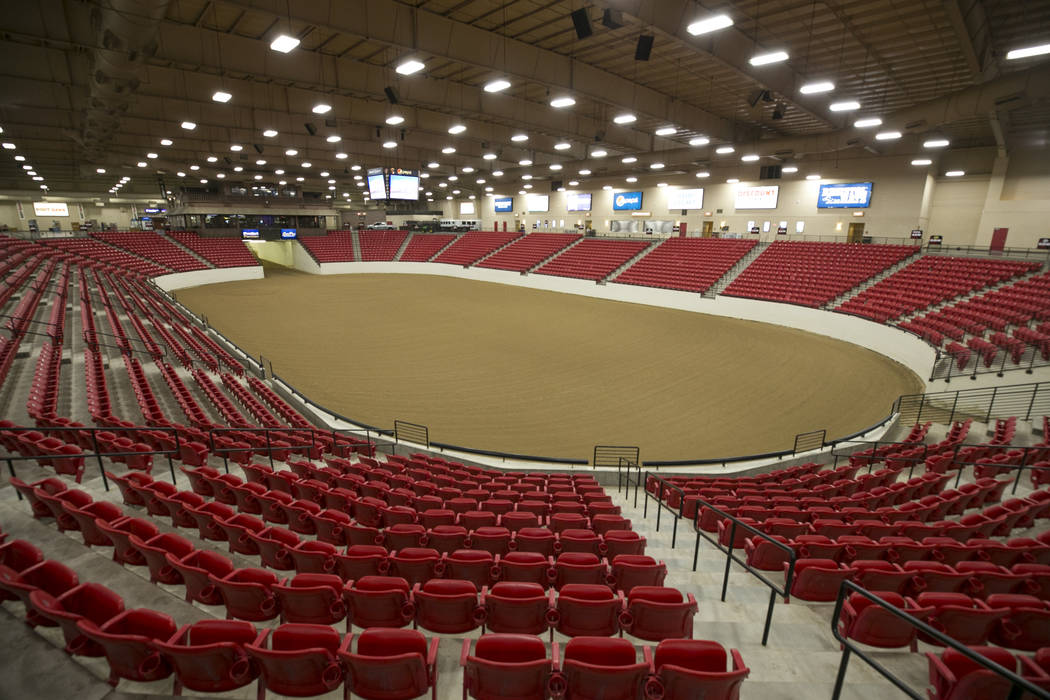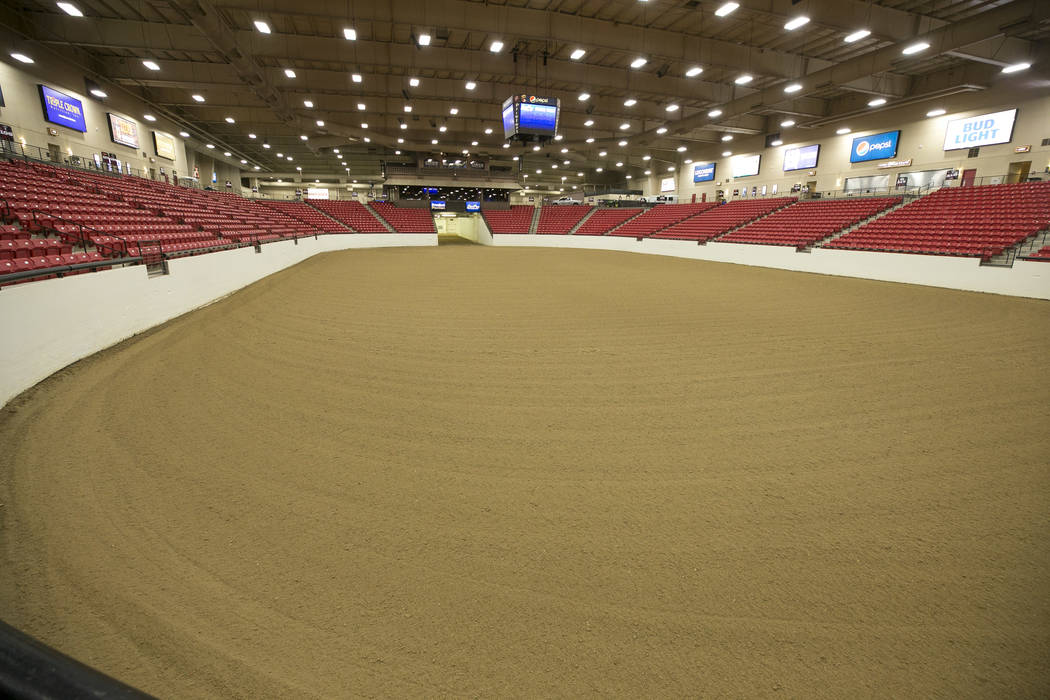Las Vegas arena team specializes in prepping dirt for events
Joe Baumgartner and his team of four might just have the dirtiest jobs in the Las Vegas casino industry.
They don’t launder money, and they don’t engage in racketeering. They are far from that underworld.
Rather, the men haul, churn and water millions of pounds of earth at the South Point Arena and Equestrian Center on a regular basis.
Baumgartner’s arena operations team makes it possible for the South Point to host an equestrian event one week, a basketball game the following week and a roping competition the third without participants and fans sensing the change.
The South Point might be the only casino in the United States to have an arena specializing in equestrian events. Thus, it is likely the only casino with teams such as Baumgartner’s that spend a good part of their time moving and grooming dirt.
“Joe and his team are the offensive line of the casino. They do the blocking and tackling every day. And we don’t notice that they are there until something goes wrong,’’ says Steve Stallworth, the general manager of the South Point Arena and Equestrian Center.
The South Point Arena, opened in 2006, hosts 44 weeks of equestrian events and six weeks of other sporting events at its three arenas, a main one and two satellites. The facility is a vital part of the casino, as it generates a good portion of hotel night stays. The quicker the operations team can turn around the arena, the more events the resort can host.
BMX to equestrian
Roughly 8 million pounds of earth stand in a pile 20 feet high in the center of the 4,600-seat South Point Arena shortly after 6 a.m. on a Monday in late July.
The members of the casino’s arena operations team are climbing into two dump trucks, a front loader and grader for a long day of labor, some with chewing tobacco in their pockets.
Just 15 hours earlier, this big pile of earth was a BMX race track consisting of smooth, short bumps and long curves. Hundreds of BMX riders from around the country competed on it over the weekend.
But a horse trainer is scheduled to host a walkabout show here in a few days. That requires different dirt, or “footing’’ as it is called in the equestrian industry.
The BMX dirt, which was hauled in a week earlier, now has to be trucked back to its resting place in the west parking lot behind the South Point.
Before that operation can start, the BMX dirt — as well as the “base dirt” beneath it — must be wet down to avoid turning the arena into a dust bowl as the yellow Volvo dump trucks drive in and out.
It will take the South Point’s arena operations team about 10 hours over two days and 180 dump truck runs to clear out the dirt. Each round trip will take about six minutes to complete.
“Today is a grueling day, just truck in, dirt out. We will work until 2 p.m. doing nothing but straight dirt,’’ says Baumgartner as he stands by the Volvo front loader he will be operating for the day.
The piles of dirt will be flattened by the grader into a thin, rectangular pancake and sprayed with water to keep it from flying away.
Until it is needed again indoors, the dirt will become a feeder lot for the horses and bulls that travel here for competitions.
It is not the only earth stored in the west lot. Nearby are piles of jumping horse dirt and cutting horse sand used for other equestrian events.
A quick glance at Baumgartner’s clothing accessories hint that he arrived at the South Point from the equestrian industry and not from the gaming side.
Baumgartner, who sports a Cactus Ropes cap and large Pendleton Round-Up belt buckle, was a professional bullfighter for 18 years. He was inducted into the Pro Rodeo Hall of Fame in 2013. His dirt specialist Todd Jepson is a former roper.
Not all dirt is equal
The 8 million pounds of BMX dirt that is being hauled out on this July morning is used in the arena just two times a year.
Jumping horse dirt contains some material from shredded tennis shoes. That dirt is brought inside just once a year for a weeklong equestrian jumping event held in November. On the other 358 days of the year, the pile, weighing about 6 million pounds, sits in the same parking lot. It might be worth as much as $750,000, according to Baumgartner.
Next to the jumping horse dirt are two piles of cutting sand, one white and another darker from being soiled with manure. The sand is used about four times a year for competitive events.
The South Point spends about $40,000 a year to replenish its dirt needs, Stallworth says.
Most of the equestrian events at the South Point use just a base dirt, which has less clay than the BMX dirt and is neither as “cushiony’’ as the jumping horse dirt nor fine and loose like the cutting sand.
The base dirt, which weighs about 3.6 million pounds, is hauled out for the jumping horse events and sporting events like basketball and wrestling. It requires 100 dump truck runs to get it out.
For cutting horse competitions, 6 inches of sand is placed on top of the base dirt.
Making dirt balls
Getting one dirt out and another in is just half the battle to putting on events in the equestrian arena.
As the base dirt is brought back inside after the horse jumping or basketball competitions, it is leveled to a depth of about 14 inches by a grader.
The wheels of the dump trucks and grader turn the base dirt rock hard. Thus, it has to be watered and then torn up by a tractor with ripper teeth.
The dirt is then carefully “groomed’’ to a specific depth and moisture using a Kiser Arena Groomer, which Stallworth says is the equestrian equivalent of ice hockey’s resurfacer.
Some equestrian events require the dirt to be groomed to a minimum depth of 4 inches while others might require just 2 inches, says Todd Jepson, the team’s dirt specialist for the past five years.
“The depth makes a huge difference. If the dirt is too shallow, the arena becomes pretty slick, and it’s hard for the horses to turn,’’ Jepson says.
The dirt’s parameters have to be the same around the arena over the course of the event. However, the moisture can change during the day. So too can the depth as horses and bulls pound on it.
“In a 10- to 12-hour period, it can change dramatically. It either gets too shallow or too dry, and it’s not suitable for other competitors,’’ Jepson says.
Jepson inspects the dirt with event organizers before and during events to make sure it meets their criteria. Some organizers just eye it while others will make a dirt ball with their hand, Jepson says.
Jepson will usually groom equestrian events with the groomer before, during and after the event.
“On the depth and wetness of the dirt, Todd does all of it. He knows his dirt better than anybody,’’ Baumgartner says.
Steamrolling dirt
The presence of rocks and pebbles is another factor that can affect performance during equestrian games. While it only takes a few hours to sort through 1,200 cubic yards of base dirt, that can only happen when all 14 inches are very dry.
“The process of rock picking is like sifting dirt through a strainer,’’ Jepson says.
The drying process takes about six days, he says, adding the operations team will keep the arena doors open at times to speed up the drying.
Once dried and rock-picked, the dirt requires “a whole lot of grooming’’ to get the moisture back in to a sufficient depth. That can take up to two days.
For non-equestrian sporting events, when the dirt is brought outside, the floors have to be washed and polished, the walls painted and everything dusted.
The operations team can turn around the arena for a different event in under 24 hours if required. The work hours vary as widely as the arena events, says Baumgartner, who has slept a few times in his office during those intense periods.
The recent BMX event came on the heels of an equestrian event. There would not have been enough time to get the base dirt out and the BMX in.
Thus, the operations team rented a steamroller to make the base dirt as hard as concrete. That enabled them to place the BMX dirt on top without worrying about the two mixing.
Stallworth says there are still a handful of big equestrian events he would like to attract to Las Vegas, but that wouldn’t completely end dependence on other sports and the need to move so much earth.
‘‘We would love it if we could just leave the dirt inside. But if you want to be booked every week, you have to do more than equestrian,’’ Stallworth says.
Contact Todd Prince at tprince@reviewjournal.com or 702-383-0386. Follow @toddprincetv on Twitter.




































